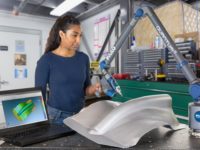The Many Applications of 3D Scanning

Issues in production are inevitable. To ensure that parts meet quality controls and customer requirements, manufacturers must occasionally inspect and adjust their processes.
This is where 3D scanning comes in. This technique is a versatile, flexible, and fast way alternative to the CMM that can remain free for final inspections. Structured-light 3D scanners, for example, measure the three-dimensional shape of an object using a single light source, which projects multiple lines on an object that is measured by cameras. These are alternatives to laser scanners, which produces numerous laser dots on single objects.
In addition, 3D scanning can reverse engineer successful tooling to produce CAD data, complete intermittent quality controls, and quickly fix unexpected issues. They can also reverse engineer products to find volume measurement of engineering parts, and capture motion and environment information for applications such as virtual reality games, body measurements for retail, and obstacle detection systems in the aerospace field. Such scanners are often handheld, which makes it easy to deploy multiple scanners for 3D printing purposes. By using structured light technology, the scanners use projecting a pattern of light onto an object to scan.
Key Market Trends in 3-D scanning
The 3D scanning market, which was valued at $1.4B in 2020, is expected to grow within the next five years, to approximately $4.7B. Global Market Insights, Inc., says the market could grow to $7.5B by 2027.
In addition to its industrial applications, which span architecture, construction, aerospace, healthcare, and automotive industries, this technology has found prominence in commercial applications such as video game and movie production.
“The 3D scanning market is estimated to grow at a substantial rate on the back of robust demand for 3D scanning solutions in the aerospace & defense sector for the correct measurement of components and parts,” says Global Trade Mag.com. “Since the sector complies with strict regulations related to the measurement of parts, authorities use 3D scanning solutions to scan assembled aircraft and its components.”
This is because 3D scanning software enables the formation of a precise 4D image based on the data collected by scanners, the publication says. As such, the software can be utilized for the scan to BIM and scan to CAD models in the architecture industry.
3D scanning has many other key attributes. It enables manufacturers to elevate their designs, helps businesses gather data, including information on development times. It also scans complex surfaces quickly and with detail, improving design quality.
As the manufacturing industry evolves toward smart factories, quality control remains key. As such, high-speed, high-accuracy, and high functioning testing equipment -- even in harsh environments – remains essential in mass-production.
Looking for a reprint of this article?
From high-res PDFs to custom plaques, order your copy today!






